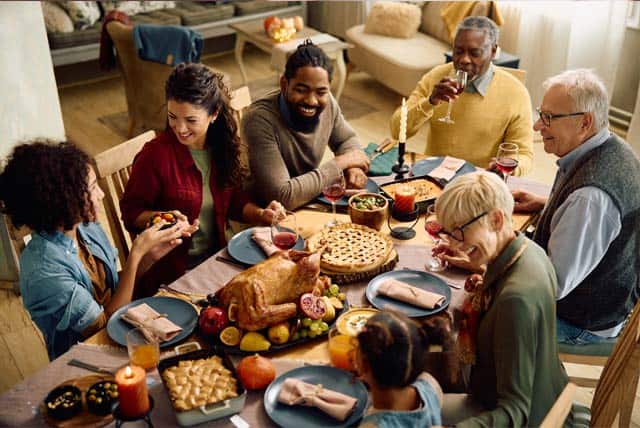Thanksgiving Day in America centers around gratitude. A ‘feast’ or large meal is a quintessential part of Thanksgiving Day for many people to celebrate things they’re thankful for. Wherever you are in your weight loss journey, a Thanksgiving meal and other food-focused holidays can pose a formidable challenge. Read on for tips to have a healthy holiday and avoid the typical Thanksgiving weight gain.
Plan Ahead for a Healthy Holiday
Having a plan can be the difference between success and failure. Make a plan to address the aspects of your Thanksgiving Day you can control and do your best to stick to it. The tips below will help guide you in your plan. A gentle reminder though, to approach this holiday with flexibility. A healthy holiday is about more than the food you eat, it includes positive interactions and low stress.
8 Tips to Avoid Thanksgiving Weight Gain
1. Workout the day before and after a holiday.
Multiple days out of routine can be a challenge to come back from, but one day off from routine is just a blip. Stay active in the days leading up to and following Thanksgiving to keep your metabolism steady. Consider how much activity it will take to work off certain indulgences (Source: www.health.harvard.edu).
Recent studies show weight gain during the winter holidays doesn’t happen from one day of indulgences and lower activity levels. Holiday weight gain is a result of repeated days of higher caloric intake and lower levels of activity. Individuals with obesity or overweight are more likely to gain more during this time period or have trouble losing weight post-holiday. (Source: www.nejm.com).
2. Don’t take a vacation from healthy eating.
Use the same mindset mentioned above for working out. Follow your normal eating routine the day before and after a holiday. If you stray from your healthy eating plan during your Thanksgiving meal go back to normal the next day.
3. Sample. Don’t “mound”.
A lot of Thanksgiving dishes can have feelings and memories attached. Depriving yourself of these could cause overindulgence later. Take small portions of your favorites that are on the table (https://www.health.harvard.edu/). Try not to create a mound of any food other than leafy greens!
4. Walk after your big meal.
Carve out time for exercise to prioritize your health and well-being. Walking following a meal helps our digestive systems work more efficiently. Walking after a large meal can help “move” it through our bodies, rather than sitting. (Source: www.time.com)
Taking a walk is a great opportunity for some alone time if your celebration involves a lot of people. It also affords you an opportunity to connect with just one or two people for deeper, more personal conversations. If you’re celebrating alone, schedule a walk with a friend when you are both available.
5. Stay in your typical healthy eating routine the rest of the day.
If you maintain your typical eating pattern, you’ll be less likely to overindulge at the Thanksgiving Meal. Don’t fall into the trap of not eating to “save room” for the big meal. Instead, eat small meals particularly breakfast, that are high in protein and fiber to keep you feeling full, so you don’t show up to Thanksgiving famished. (Source: dahlc.mayoclinic.org)
6. Limit alcohol consumption.
Alcohol has lots of hidden sugar and calories that can hurt your weight loss efforts. Not to mention slowing down bodily systems that impact your metabolism. It can also impair your decision making with food choices. (Source: www.mayoclinichealthsystem.org)
If you’re in Phase 1 or 2 of Options Diet System (ODS), it’s recommended you abstain from alcohol altogether. However, we understand food-centered holidays can make this a challenge. Bring a low-sugar mocktail. If that won’t suit you, plan ahead a low-calorie, low-sugar beverage you plan to have and only have one. (Source: www.myhealth.va.gov)
7. Provide a healthy Thanksgiving side dish.
Be a part of the solution to foster a healthy holiday meal. Bring a healthy dish to pass (and eat) at the event. (Source: dahlc.mayoclinic.org) Prepare fresh or roasted veggies, a hearty salad and a delicious, low-carb side dish. Providing healthy holiday options at your meal ensure you’ll have dishes available that won’t cause Thanksgiving weight gain.
Try this ODS-friendly mashed cauliflower recipe or one of these healthy thanksgiving recipes (Source: www.brit.co).
8. Log the meal in your Options Health Coach app.
If you track your meals, don’t skip recording your holiday meal. Record it. See the numbers. Move forward. Don’t obsess over it in the moment. Follow our tips and those of your Options Weight Loss Health Coach to stay on track.
Reminders
Remember, these are general suggestions. If you’re in Phase 1 or 2 of ODS, please discuss your plans with your weight loss health coach. An Options Weight Loss Health Coach can tailor suggestions to you no matter where you are on your weight loss journey.
ENJOY your time!
Hopefully you’re spending time with loved ones and can relax, laugh and share memories. Remember stress and lack of sleep can impede weight loss and your general health (Source: www.cdc.gov). So, ask others to help. Excuse yourself for alone time. Turn on your favorite music. Take a deep breath and find three things you are grateful for.

